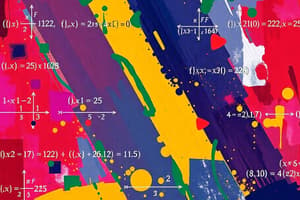Podcast
Questions and Answers
What is the formula to find the roots of a quadratic equation in standard form?
What is the formula to find the roots of a quadratic equation in standard form?
- $x = \frac{b \pm \sqrt{4ac-b^{2}}}{2a}$
- $x = \frac{-b \pm \sqrt{b^{2}-4ac}}{2a}$ (correct)
- $x = \frac{-b \pm \sqrt{b^{2}+4ac}}{2a}$
- $x = \frac{b \pm \sqrt{b^{2}-4ac}}{2a}$
In the method of completing the square, what must be added to both sides after moving the constant term?
In the method of completing the square, what must be added to both sides after moving the constant term?
- (b/2a)$^2$ (correct)
- (b/2 + a)$^2$
- (b/2)$^2$
- $\sqrt{b^{2}}$
Which method can be used directly for equations that can be written as $x + a = 0$?
Which method can be used directly for equations that can be written as $x + a = 0$?
- Completing the Square
- Quadratic Formula
- Factoring
- Taking the Square Root (correct)
In the factoring of quadratics, if the leading coefficient is not 1, what is the first step?
In the factoring of quadratics, if the leading coefficient is not 1, what is the first step?
What type of quadratic equation can be solved using the taking the square root method?
What type of quadratic equation can be solved using the taking the square root method?
What is the correct final answer for the equation $x^2 - 16 = 0$?
What is the correct final answer for the equation $x^2 - 16 = 0$?
In which scenario would a quadratic equation commonly be applied?
In which scenario would a quadratic equation commonly be applied?
What form must a quadratic equation be in to apply the quadratic formula?
What form must a quadratic equation be in to apply the quadratic formula?
What is the general form of a quadratic equation?
What is the general form of a quadratic equation?
What do the coefficients a, b, and c represent in a quadratic equation?
What do the coefficients a, b, and c represent in a quadratic equation?
What happens if coefficient a equals zero in a quadratic equation?
What happens if coefficient a equals zero in a quadratic equation?
What are the solutions of a quadratic equation commonly called?
What are the solutions of a quadratic equation commonly called?
How many roots or solutions does a quadratic equation typically have?
How many roots or solutions does a quadratic equation typically have?
What is the formula used to find the roots of a quadratic equation?
What is the formula used to find the roots of a quadratic equation?
Which of the following statements regarding a quadratic equation is incorrect?
Which of the following statements regarding a quadratic equation is incorrect?
In the quadratic formula, what does the '±' sign indicate?
In the quadratic formula, what does the '±' sign indicate?
Flashcards are hidden until you start studying
Study Notes
Definition and General Form
- Quadratics are polynomial equations of the second degree, characterized by at least one squared term.
- The general form is given by ax² + bx + c = 0, where x represents the unknown variable and a, b, c are numerical coefficients.
- In this equation, a cannot be zero; if it is, the equation becomes linear.
Roots and Solutions
- Solutions of the quadratic equation are known as roots or zeros.
- There are typically two roots for quadratic equations, which satisfy the equation when substituted back.
- Roots can also be referred to as the values of x that make the equation true, leading to a result of zero.
Characteristics of Quadratic Equations
- Quadratics are univariate since they contain a single variable (x).
- The highest degree of the polynomial in quadratics is two, denoting its second-degree nature.
- Polynomial zeros signify the solutions that equalize the polynomial expression to zero.
Quadratic Formula
- The quadratic formula for finding roots is given by x = [-b ± √(b² - 4ac)]/2a.
- The ± sign indicates two potential solutions for x due to the square root.
Methods for Solving Quadratic Equations
- Factoring: Rearranging the quadratic to find factors (e.g., (2x+3)(x-2)=0).
- Completing the Square: Rearranging and manipulating the equation to represent it in squared form.
- Using the Quadratic Formula: Directly applying the quadratic formula to find roots.
- Taking the Square Root: Applied for simpler quadratics such as those reducing to form x² = k.
Example Equations and Problem Solving
- Solving equations like 3x² - 5x + 2 = 0 or x² - 6x = 16 can be done through factoring or the quadratic formula.
- Examples illustrate checks for solutions by substituting back into the original equation.
Applications of Quadratic Equations
- Quadratic equations are applicable in various real-world scenarios, particularly in solving speed problems and geometric calculations.
Studying That Suits You
Use AI to generate personalized quizzes and flashcards to suit your learning preferences.




